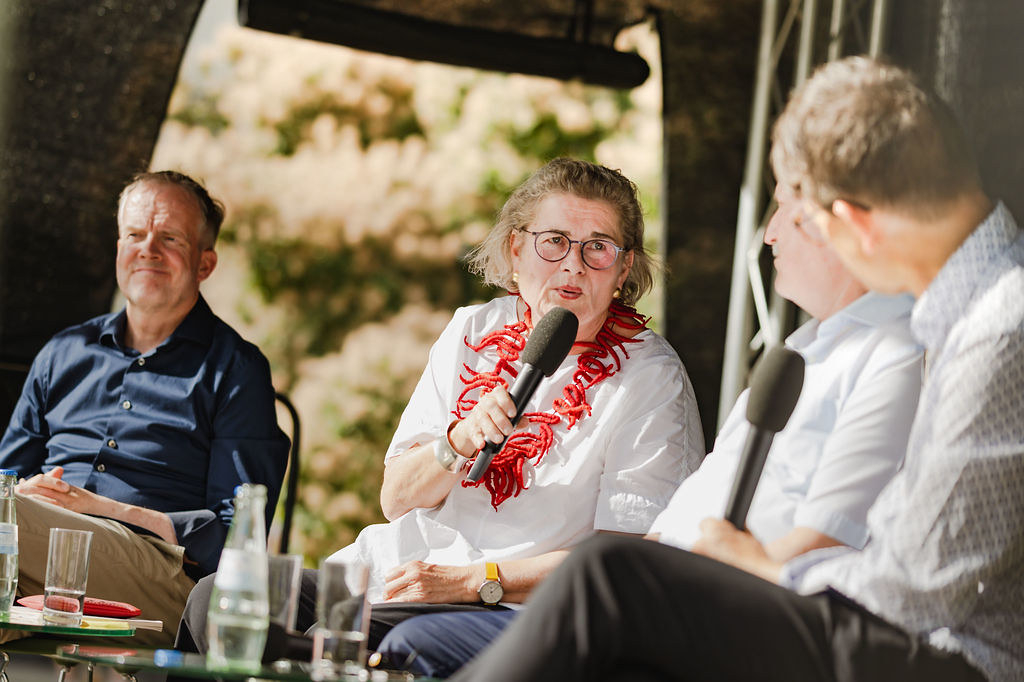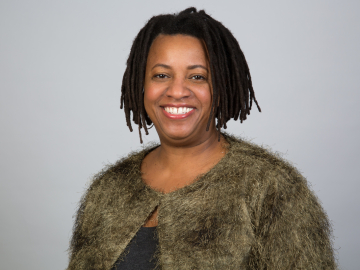Building Berlin’s future on historic ground

On July 5, 2025, residents, students, families, and guests from across Berlin gathered in the garden of ESMT Berlin to celebrate summer in the heart of the capital and to engage in a vital conversation about the future of their neighborhood. The highlight of the afternoon was a panel discussion on urban development on the Spreeinsel, moderated by Jan Linders of the Humboldt Forum, featuring Berlin’s Chief Urban Planner Prof. Petra Kahlfeldt, former Humboldt Forum technical board member Hans-Dieter Hegner, and ESMT’s Director of Real Estate Georg Garlichs.
The event exemplified what Kahlfeldt called the power of cross-institutional cooperation: “I find it absolutely wonderful – speaking with one voice as neighbors.” This unity among the Spreeinsel’s “high-caliber neighbors” – Bertelsmann Stiftung, Bundesstiftung Bauakademie, ESMT Berlin, Hochschule für Musik Hanns Eisler Berlin, Humboldt Forum, PETRI Berlin, WBM Wohnungsbaugesellschaft Berlin-Mitte mbH – is proving essential to shaping one of Berlin’s most historic and dynamically evolving districts.
ESMT’s growing campus: expansion with environmental responsibility
As host of the event, ESMT unveiled its contribution to the neighborhood’s evolution. Garlichs outlined plans for three new buildings along the campus perimeter: a 150-bed student residence (“our small contribution to easing Berlin’s housing market,” as he put it), a mid-sized office building, and a larger facility to support the school’s long-term growth.
Crucially, the historically protected center garden will remain unchanged, and the school plans to make river access even more attractive. This approach demonstrates how institutional growth can enhance rather than compromise neighborhood character.
In a gesture of immediate community engagement, Garlichs announced the September opening of the restored courtyard fountain, offering a cooling, welcoming space for students and neighbors alike. “Our campus is open most days – almost around the clock – for students and visitors alike.”

Housing with vision: integrating past and future on Breite Straße
The centerpiece of the discussion was the ambitious housing project planned for Breite Straße, led by the state-owned WBM. Five new residential buildings will rise on the currently vacant site, with 50 percent offering rent-controlled units priced between €7 and €12 per square meter – a deliberate choice that reflects Berlin’s commitment to mixed-income communities.
“We want a mixed city,” Kahlfeldt explained to an audience member who questioned why such an exclusive location wouldn’t focus on high-end housing. “The address alone should not determine who belongs here.”
This philosophy extends beyond mere economics to encompass Berlin’s cultural identity: one building will house artist studios and a gallery, creating what planners are calling a “House of Art” that will contribute to the area’s creative ecosystem.
Notably, the development will integrate significant archaeological findings into its ground-level and basement spaces, creating a public-facing reminder of Berlin’s deep historical layers. This innovative approach transforms construction challenges into cultural opportunities, allowing residents and visitors to literally walk through centuries of Berlin’s history.
The Humboldt Forum has already signed a preliminary lease for office space in the development, helping consolidate its growing operations near the main exhibition venue – a practical example of the institutional coordination that defines the Spreeinsel’s development strategy.
Climate-responsive urban design: reimagining the Schlossplatz
The panel also addressed one of Berlin’s most pressing urban challenges: adapting public spaces to increasingly hot summers. The southern forecourt of the Humboldt Forum, completed shortly before the pandemic, has proven inhospitable during peak temperatures – a problem that city planners are now addressing directly.
Hegner outlined an ambitious redesign initiative that reads like a botanical world tour: “We are traveling around the world – with 80 trees from Asia, America, and Europe.” The climate adaptation strategy includes three new “tree islands” offering shade and seating, and a contemporary fountain at Portal II of the Humboldt Forum that the city will select through a design competition beginning in 2026.
"You must be able to see water and hear water," stated Kahlfeldt. “Most of the time, when there’s a fountain, children sit in it or adults dip their feet,” she said with a smile. “After a long visit, you just want to cool your feet and rest in the shade. Why not?” This detail, small as it seems, reflects a broader philosophy about public space – that it should be not just functional but genuinely welcoming and human-scaled.
The fountain design will need to balance contemporary aesthetics with historical sensitivity, reflecting what Kahlfeldt called the site’s “historical significance.” This challenge of honoring the past while planners create spaces for the future runs through every aspect of Spreeinsel development.
Community voices: from construction fatigue to collaborative vision
The open question session revealed the deep engagement of residents with their neighborhood’s transformation. One visitor expressed hope for an end to the “permanent construction site feeling” that has characterized Mitte in recent years. Kahlfeldt acknowledged this fatigue while pointing to the light at the end of the tunnel: “I have the feeling we are now at the harvest time,” she said, referring to the many projects now entering implementation phases.
Another guest brought a practical suggestion from Chemnitz: incorporating sitting stones in the fountain water for cooling off – an idea that Kahlfeldt received with interest, demonstrating the collaborative spirit that defines the Spreeinsel’s development process.
These interactions highlighted something often missing from urban planning discussions: the recognition that development is not just about buildings and infrastructure but about creating spaces where communities can thrive.
A model for urban development
The Spreeinsel panel discussion revealed more than just construction plans; it showcased a model for how cities can develop responsibly in the 21st century. By bringing together government officials, institutional leaders, and community members in the same space, the event demonstrated that meaningful urban development requires ongoing dialogue rather than top-down planning.
The commitment to mixed-income housing, climate adaptation, historical preservation, and community engagement reflects a maturation in urban planning thinking. As Kahlfeldt noted, “We are already harvesting the fruits of past planning. And as this festival shows, we are building that future together.”
With contributions from the city, the federal government, and major cultural and educational institutions, the Spreeinsel is being transformed into a more livable, inclusive, and environmentally responsive urban space. The conversation that began in ESMT’s garden represents not just neighborhood planning, but a template for how democratic societies can shape their urban futures.
See the photos of “Neighborhood Festival – Summer on the Island” by photographer Ana Torres on Flickr.
Interested in our events?
Neighborhood Festival – Summer on the Island
